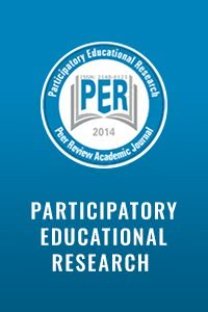Investigation of an Online Learning Environment in Terms of Usability
Usability, Usability test, Online learning,
___
- Ağır, A. (2013). Uzaktan Eğitim Programlarında Öğrenme Yönetim Sistemleri ve Canlı Ders Yazılımları [Learning Management Systems and Web Conferencing Systems in Distance Education Programs]. National Distance Education and Technology Symposium, Selçuk University, Konya, 50-64.
- Anderson, T. (2003). Modes of interaction in distance education: Recent developments and research questions. In M. G. Moore & W. G. Anderson (Eds.), Handbook of distance education (pp. 129–144). Mahwah, NJ: Erlbaum.
- Bailey, B. (2006). Getting the Complete Picture with Usability Testing. Retrieved July 25, 2009, from http://www.usability.gov/articles/newsletter/pubs/030106news.html.
- Carlson, K. (2011). Using Adobe Connect to deliver online library instruction to the RN to BSN program. Journal of Library & Information Services in Distance Learning, 5(4), 172-180.
- Cappiccie, A., & Desrosiers, P. (2011). Lessons learned from using Adobe Connect in the social work classroom. Journal of Technology in Human Services, 29(4), 296-302.
- Çağıltay, K. (2011). İnsan Bilgisayar Etkileşimi ve Kullanılabilirlik Mühendisliği: Teoriden Pratiğe [Human Computer Interaction and Usability Engineering: From Theory to Practice]. Ankara: METU Press.
- Delice, M., & Odabaşı, M. (2014). Police Students’ Satisfaction of Courses and Instructors: Does it affect Academic Success?. Journal of theoretical educational science, 7(4), 550-572.
- Durdu, L., & Durdu, P. (2013). Çevrimiçi Öğrenme Ortamları [Online Learning Enviroments]. In K. Çağıltay, & Y. Göktaş (Eds.), Öğretim Teknolojileri Temelleri: Teoriler, Araştırmalar, Eğilimler [Foundations of Instructional Technology: Theory, Research, and Trends] (pp. 535-552). Ankara: Pegem Academy.
- Fırat, M., & Kabakçı Yurdakul, I. (2013). Açık ve Uzaktan Öğretimde E-Öğrenme Araçları ve Yeni Yönelimler [E-learning Tools and New Tendencies in Open and Distance Education]. In Yüzer, V., Yomamoto, G.T., & Demiray, U (Eds). Türkiye’de E-Öğrenme: Gelişmeler ve Uygulamalar IV [E-learning in Turkey: Developments and Practices IV]. Eskişehir. Chapter 2.
- Gürses, E.A. (2006). Usability in Library WEB Sites and Design Based on Usability Guidelines. ( Phd thesis). Hacettepe University Graduate School of Natural and Applied Sciences, Ankara.
- Hew, K.F., Cheung, W.S. & Ng, C.S.L. (2009). Student contribution in asynchronous online discussion: a review of the research and empirical exploration. Instructional Science, 38(6), 571-606.
- Hirumi, A. (2011). The design and sequencing of online and blended learning interactions: A framework for grounded design. Canadian Learning Journal, 16, 21–25.
- Ilgaz, H. (2014). The Problems of Distance Education Students on Synchronized Learning Applications and Suggestions for Solutions. Educational Science and Practice, 13(26), 187-204.
- Karabulut, A. & Correia, A. (2008). Skype, Elluminate, Adobe Connect, Ivisit: A comparison of Web-Based Video Conferencing Systems for Learning and Teaching. In K. McFerrin, R. Weber, R. Carlsen & D. Willis (Eds.), Proceedings of Society for Information Technology & Teacher Education International Conference 2008 (pp. 481-484). Chesapeake, VA: Association for the Advancement of Computing in Education (AACE).
- Khan, B.H. (2000). A framework for web-based learning. TechTrends, 44(3), 51-51.
- Krug, S. (2007). Don't Make Me Think! A Common Sense Approach to Web Usability. USA: Pearson.
- Kuo, -C.Y., Belland, R.B., Schroder, E.K., & Walker, E.A. (2014). K-12 teachers’ perceptions of and their satisfaction with interaction type in blended learning environments. Distance Education, 35(3), 360-381.
- Lewis, J.R. (2005). Introduction to Usability Testing. Tutorial given at HCI International 2005, July 22-27, Las Vegas, USA.
- Moore, M. G., & Kearsley, G. (1996). Distance education: A systems view. Belmont, CA: Wadsworth.
- Muilenburg, L. Y., & Berge, Z. L. (2005). Student barriers to online learning: A factor analytic study. Distance Education, 26, 29–48.
- Mutlu, M.E., & Gümüş, S. (2009). The Use of Virtual Classroom Technologies in the Native Language Education of Turks Living In Europe. Paper presented in IInd International Congress of European Turks. Antwerp, Belgium, May 2009.
- Nielsen, J. (1994). Usability Engineering. San Francisco: Morgan Kaufmann.
- Özdemir, S., Atasoy, B., & Somyürek, S. (2007). Usability of a Software Running Administration of Business Processes of Scientific Journals: Investigation of The First Example in Turkey. Gazi University Journal of Gazi Educational Faculty, 27(2), 57-80.
- Pala, K.F., & Erdem, M. (2015). Çevrimiçi Öğrenme Ortamları ve Katılım [Online Learning Enviroments and Engagement. In B. Akkoyunlu, A.İşmam, & H.F. Odabaşı (Eds.), Eğitim Teknolojileri Okumaları 2015[Educational Technology Readings] (pp. 213-232). Ankara: Pegem Academy.
- Seiver, G.J, & Troja, A. (2014). Satisfaction and success in online learning as a function of the needs for affiliation, autonomy, and mastery. Distance Education, 35(1), 91-105
- Todhunder, B. (2013). LOL — limitations of online learning — are we selling the open and distance education message short?. Distance Education, 34(2), 232-252.
- Uzun, F.D. (2012). Siteyi Test Etme ve Düzenleme [Web Site Testing and Editing]. In Şengel E., & Özdemir S. (Eds.), Web Siteleri İçin Kullanılabilirlik Ölçümleri [Usability Metrics for Web Sites], (pp. 93-128). Ankara: Ekin
- Uzunboylu, H., & Tuncay, N. (2012). Uzaktan Eğitimde Sanal Değişimler [Virtual Changes in Distance Education]. Ankara: Pegem Academy. Usability.gov. Sytem Usability Scale (SUS) (2015). Retrieved June 29, 2015, from http://www.usability.gov/how-to-and-tools/methods/system-usability-scale.html.
- Wong, K.S., Nguyen, T.T., Chang, E., & Jayaratna, N. (2003). Usability Metrics for E-learning. In R. Meersman & Z. Tari (Eds.), OTM Worshops 2003, (pp. 235-252). Berlin: Springer.
- Yıldırım, B.F., Güneri, Y.O., & Aydın, Ç.Y. (2015). Police Students’ Satisfaction of Courses and Instructors: Does it affect Academic Success?, Journal of Theory and Practice in Education, 11(2), 521-533.
- Yılmaz, U. E. O. ve Aktuğ, Ö. G. S. (2011). The Opinions of Online Distance Course Education Instructors on the Interaction and Communication in Distance Education. XIII. Proceedings of Academic Information and Communication Conference, İnönü University, Malatya, 469-480.
- ISSN: 2148-6123
- Yayın Aralığı: Yılda 6 Sayı
- Başlangıç: 2014
- Yayıncı: Özgen KORKMAZ
Fikile MBULİ, Norma R. A. ROMM
Sevilay KARAMUSTAFAOĞLU, Recep ÇAKIR, Ayşegül CELEP
Bilal ÖZÇAKIR, Cahit AYTEKİN, Bülent ALTUNKAYA, Bekir Kürşat DORUK
Hakan TÜRKMEN, Damla Dilara TOPKAÇ
Melih KAZİMLAR, Yesim KESLİ DOLLAR
Fatih ERDOĞMUŞ, Mıustafa KOKOÇ, Eda PİNAL, Şeval BİLGİ, Zeynep MURAT
